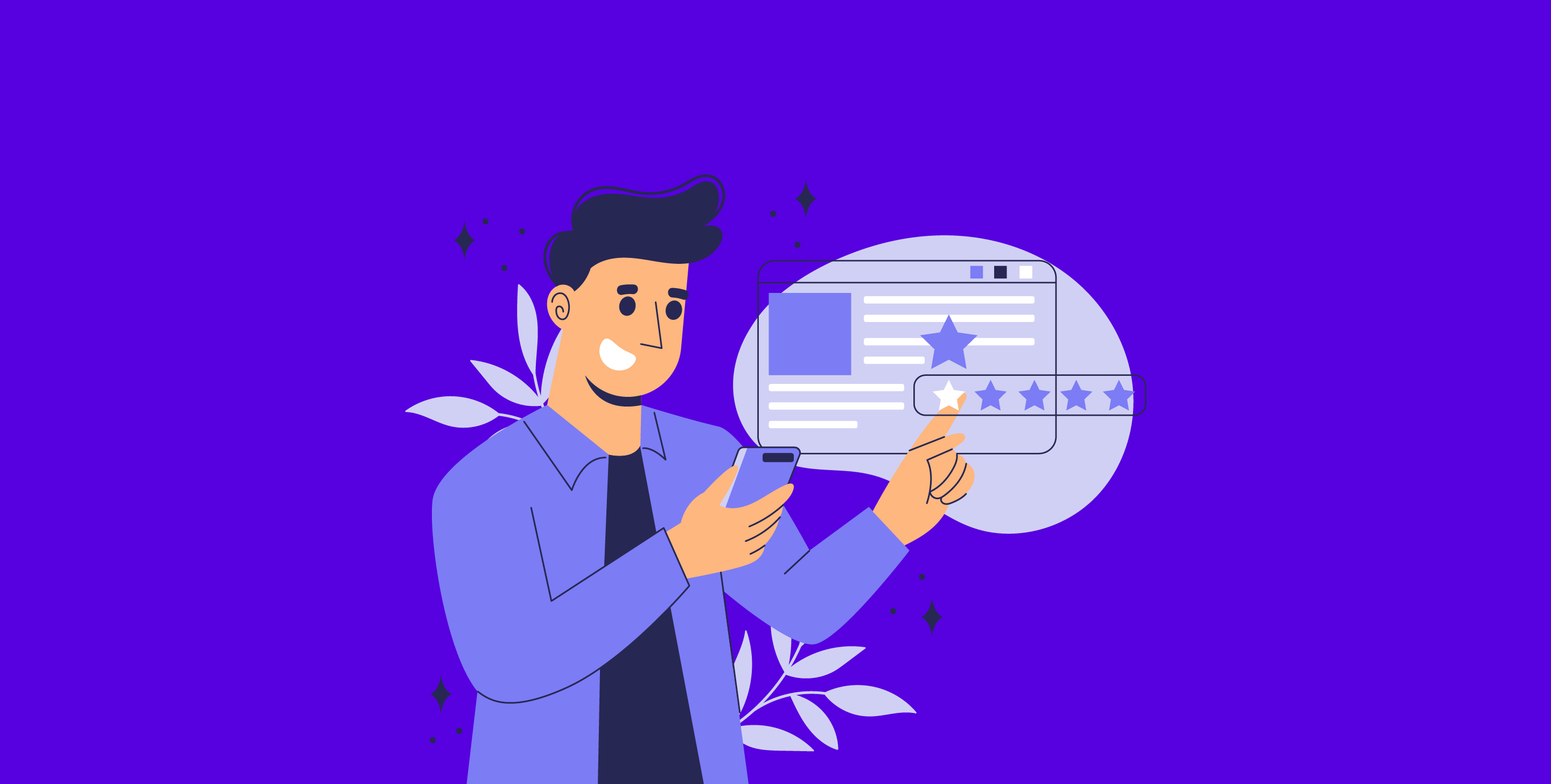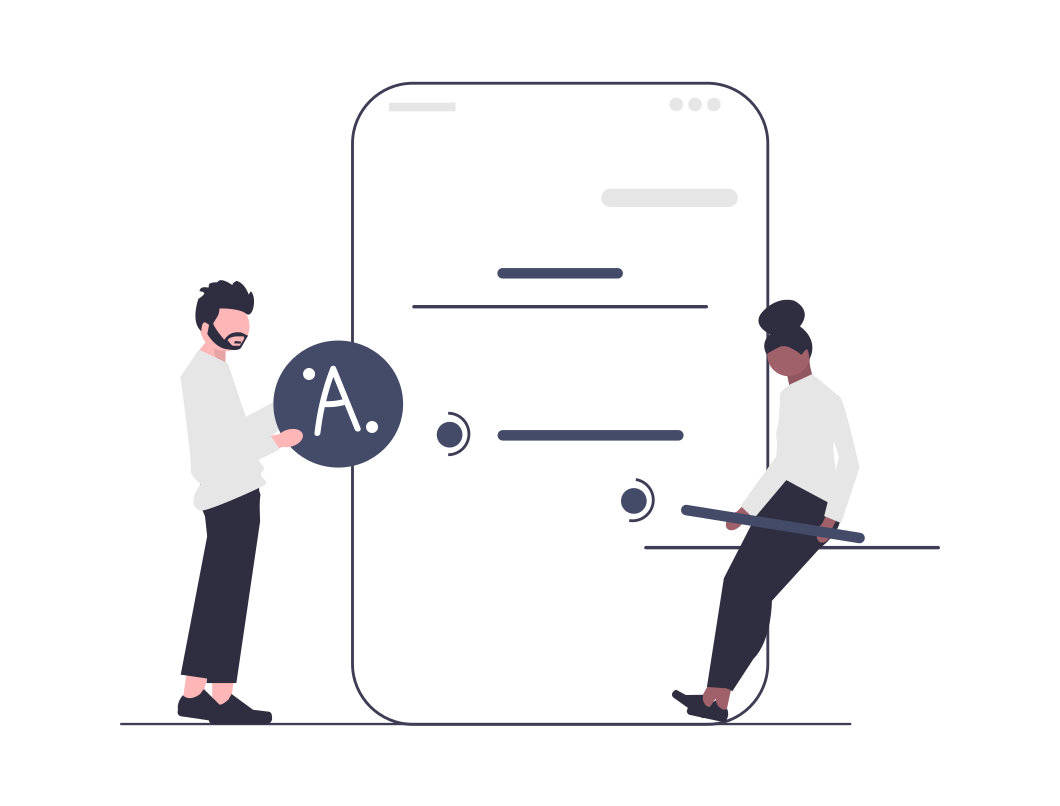Customer Experience
The 5 Stages of the eCommerce Customer Journey in 2024
Article written by Kate William
Content Marketer at SurveySparrow
16 min read
19 September 2025

In today’s age, eCommerce has become a pivotal part of our lives. It is impossible to think of a time when we couldn’t order something online. From groceries to jewelry, everything is available at the click of a button.
Well, a few buttons. With the increasing number of eCommerce stores, business owners should find ways to streamline the experience of their customers.
This is where mapping the ecommerce customer journey becomes important.
- Define an ecommerce customer journey
- Explain modeling the ecommerce user journey matters
- Explore the stages of an ecommerce user journey
- List the 7 elements of a customer journey map
- Guide you on how to map your ecommerce user journey
What is the Customer eCommerce Journey?
An ecommerce customer journey includes the steps that a customer takes; starting from discovering that there is a need for a product to the final stage, where they buy from you.
Each of the stages they cross is referred to as a customer touchpoint and can be used to create a delightful experience for your prospective customers.
The typical ecommerce customer journey can take days, and it can involve multiple channels.

Why is the eCommerce Customer Journey Important?
An ecommerce customer journey map is pivotal for every ecommerce team. Because in order to improve your CX, we need to stop thinking in terms of funnels and start thinking in terms of experiences.
The Funnel is transactional. It serves and reflects our needs but has little to do with what the customer is experiencing and desiring.
Furthermore, it is based on the illusion that the seller still controls the marketing, selling, and sales processes. And that is no longer true. – Jeff Pedowitz, ‘Be Prepared To Step Outside The Funnel For Better CX’
In other words, a customer journey map helps you understand your target audience, what they look for, and how you can provide them with a better experience.
Moreover, by modeling the ecommerce user journey, you can visualize what your customers think and how they feel when they interact with your product. This gives you a deeper understanding of their needs, expectations, and preferences.
How Does an Ecommerce Customer Journey Map Help?
- The business will be able to understand the pain points of the customers and find insights that will help fix them.
- You will be able to connect different business parts and make them work in tandem for a seamless customer experience.
- It will help you prioritize activities that will impact your business directly.
- Find ways to be more customer-centric.
- Results in greater internal collaboration and alignment.
- Develop a customer-centric culture that puts them as the focal point of all business decisions.
For this purpose, it’s good to have an omnichannel CX tool.
SurveySparrow can help you track, analyze, and act to improve customer journeys with our Journey Chart feature. Try our software for free.
14-day free trial • Cancel Anytime • No Credit Card Required • No Strings Attached
5 Stages of the eCommerce Customer Journey: How to manage them in 2023
Stage 1: Awareness
| Journey Stage | Key Actions | Content-Type | Engagement Strategy |
|---|---|---|---|
| Awareness | Understand Brand | Blog & Videos | SEO & Analytics |
| Find Solutions | Infographics | Social Media | |
| Research Issue | Brand Education | Content Quality |
In this stage, the customer learns about you and your product. So you should find where your customers are coming from, how they landed on your website, what landing pages they spend most of their time on, etc. For example, did they find you through search engine results? Or was it through an ad on YouTube?
Additionally, the eCommerce store should track the behavior of the prospective customer. Are they more interested in a particular product? If so, do other prospects with similar characteristics show the same behavior?
Since this is the stage where a customer learns about your business, it is also a great opportunity to find out what their preferences and needs are. Follow up with solutions for these pain points.
Having an effective SEO (search engine optimization) strategy plays a huge importance in this stage. Based on how your customers behave at this stage, you should optimize your marketing and sales strategies.
In the awareness stage, your prospects are experiencing a problem and are looking at solutions for it. They are researching the issue they are having. This is when they land on your website (or any of your other channels). So newsletters, ads, banners, blogs, etc., are touch points at this stage.
Content for the awareness stage:
- Well-written blog posts and articles work extremely well in the awareness stage
- Create how-to and educational videos. Videos that talk about your brand also work. Add subtitles to your videos to ensure everyone can engage with your content.
- Make infographics that incorporate key ideas, points, statistics, etc.
- Leverage social media and develop a legion of fans.
Here’s what you should do in the awareness stage:
- Provide your target audience with information that will help them understand your brand and the values that you stand for.
- Share the benefits of using your brand’s products and services.
- Make sure the content you create in this stage is educational and informative.
- Create content that shows you as a thought leader in the industry.
Stage 2: Consideration
| Key Actions | Content-Type | Engagement Strategy |
|---|---|---|
| Product Browsing | Webinars & Podcasts | User Engagement |
| Compare Options | Product Comparison | Site Activity Monitor |
| Assess Preferences | Original Reports | Relevant Content |
At this stage, the customer shows real interest in your products or services. They are looking at other options available in the market too. Unfortunately, most businesses lose clients during this stage if they don’t find what they are looking for.
The customers must be engaged at this stage of the ecommerce journey. Otherwise, they will lose interest.
But keeping customers engaged at this stage is a big challenge. They might not look at more than one category of products. Once they start browsing your website, they might feel that it is not up to their liking.
Category filters, store pages, landing pages, etc., are touchpoints in this stage.
Content for the consideration stage:
- Develop cost calculators that the target audience can use to see how much they are saving by buying your products.
- Develop original reports and research that will show you as an industry leader.
- Hold the buyer’s attention with the help of podcasts and webinars.
- Create videos that tell a story.
- Build product comparison charts.
- Case studies, whitepapers, and landing pages.
Here’s what you should do in the consideration stage:
- Get an idea of who your prospective buyers are.
- Identify potential questions they might have and create content around them.
- Create informative content that solves the buyer’s problem.
- Constantly track the activity of your site.
Stage 3: Conversion
| Key Actions | Content-Type | Engagement Strategy |
|---|---|---|
| Make a Purchase | Testimonials | Promotions |
| Eliminate Doubts | Trials & Demos | Simple Checkout |
| Engage & Act | Consultation | Retargeting Tools |
The next step after keeping customers engaged is conversion. Thanks to your engagement activities, customers take action resulting in them making a purchase.
Many customers don’t reach the conversion stage at all. Cart abandonment is such a common phenomenon too. To improve the conversion rate, there should be a variety of things you should do.
Content for the conversion stage:
- Offer trial sessions or demos to make customers experience your product.
- Share customer reviews and testimonials to build trust.
- Write how-to articles and guides that let potential customers eliminate any doubt that they might have.
- Offer a free consultation call.
Here’s how to increase conversions:
- Hold special promotions to make the prospect of buying from you even more alluring. Discounts can get people excited and result in an increase in conversions.
- Make sure that the checkout process is simple. Don’t ask for too many details from customers. Embrace one-click checkout.
- Use shopping cart abandonment software for retargeting interested customers who almost purchased from you.
- Don’t shock your customers with a huge shipping cost at the end.
- Use high-quality images, descriptions, and videos on the product pages.
- Embrace chatbots to offer real-time solutions for customers.
Stage 4: Retention
| Key Actions | Content-Type | Engagement Strategy |
|---|---|---|
| Post-Purchase Support | Community Building | Customer Service |
| Maximize ROI | In-app Messages | Loyalty Programs |
| Customer Loyalty | Knowledge Base | Upselling |
Having people buy your products is satisfying. But what’s better is to make them keep coming back again and again. So the onus is on the eCommerce store to keep their existing customers satisfied.
In fact, a sale is the beginning of the customer experience process. The objective should be to maximize your ROI from the customer.
Metrics like customer lifetime value (CLV) tell you how much business your customer brings over the course of their association with you. It starts from their first purchase and ends when they stop buying from you. It is one of the most important metrics that eCommerce stores should track.
If your CLV is a small amount and reflects just one or two purchases, then there is something wrong with how you do business.
By increasing customer retention just by 5%, you can boost profits by more than 100%, according to a study by Harvard Business Review. This stat is a telling statement of the importance of having loyal customers. Ultimately, loyal customers are the ones who will become advocates and promoters for your brand.
Types of content for the retention stage:
- Create a separate channel for existing customers to get in touch for any queries or complaints.
- Build a community of paid customers to create a feeling of togetherness.
- Leverage in-app messages.
- Build onboarding emails.
- Create a knowledge base to help customers to use the product better.
Here’s how you should retain your customers:
- Provide strong customer service, no matter which channels they use to get in touch.
- Incentivize your customers for staying loyal to you. Use a loyalty program software like 99minds to formulate a reward program that makes them stay with you.
- Run upselling and cross-selling campaigns with special offers for existing customers.
Stage 5: Advocacy
| Key Actions | Content-Type | Engagement Strategy |
|---|---|---|
| Promote Brand | Positive Reviews | Relationship Building |
| Share Experience | Referral Campaigns | Multi-channel Engage |
| Strengthen Bonds | Testimonials | Data Outreach |
In this stage, you have customers who are die-hard fans of your brand. These are the ones who are ready to share your products with their friends and family. Moreover, they will be more than happy to write testimonials about you.
Fun fact: 88% of people trust online recommendations as much as personal recommendations.
Types of content to create advocacy:
- Build a pool of positive reviews about your brand– Google Reviews, TrustRadius, G2. Find platforms that are known as trusted recommendation platforms for your niche and establish your presence there.
- Ask for video testimonials from your customers. If you want them to mention specific features or products, request that too.
- Create referral campaigns to turn customers into new leads.
How to create advocates for your brand?
- Focus on building relationships to bring customers closer to your brand.
- Engage with customers through different channels; even phone calls are great for establishing and maintaining connections.
- Use data-driven outreach programs to build advocates.
Customer Journey Modeling: 7 Elements of an eCommerce Customer Journey Map
- Personas: Finding buyer personas helps you find the needs, expectations, and motivations of your target audience. You will understand why they want a particular product and what type of content will be most relatable for them.
- Channels: Using the right channels to interact with your customers should be found based on internal and external data.
- Duration: Define how much time it will take for customers to go from one stage to the next. Even though each customer journey is different, you can create content pieces accordingly.
- Touchpoints: A touchpoint is an interaction that your customer has with your brand. Your aim should be to make the interaction as frictionless and delightful as possible at each of these touchpoints.
- Opportunities: Based on the insights gathered from the exercise, the product team will be in a position to offer better user experiences. If opportunities aren’t identified, the journey map isn’t actionable.
- Ownership: It clearly defines who is in charge of making changes based on the opportunities identified. If there is no ownership taken, there will be no accountability.
- Moments of truth: Find out touchpoints that can be generally frustrating for most of your customers. Come up with ways to create a positive experience at this touchpoint.
How Do I Create an eCommerce Customer Journey Map?
Create buyer personas:
One of the most basic steps while mapping the online customer journey is to define your buyer personas. Below are the questions you must ask for it:
- Who are your customers right now?
- Which channels do they use?
- What kind of benefit do they get from your product?
- What are their goals, pain points, motivations, purchasing triggers, etc.?
- Why would they prefer your brand over that of your competitors?
The average business has anywhere from three to seven personas. After you create the required personas, design a customer journey map eCommerce for each persona.
Set goals:
While building buyer personas, you must also clearly write down your goals behind the customer journey mapping activity. By doing this exercise, you will be able to address various challenges that you will face in your eCommerce store since your understanding of customers will grow manifold.
Identify key touchpoints:
Make a list of every way in which your customer will be interacting with your eCommerce brand. The touchpoints could be from different channels- social media ads, retargeting emails, customer support agent interaction, blog posts, video ads, etc.
Write down the list of channels where your customers interact with your brand. Find out the different pain points that your customers face along their journey toward becoming your customer.
Create an empathy map:
Track how your customers feel when they interact with you at each touchpoint. The reason behind considering your customer’s emotional state is to understand them on a more humane level so that the interaction experience could be designed keeping this in mind. Creating an empathy map puts you in a position where you can find moments of despair and frustration when interacting with your brand and make changes accordingly.
Refine the user journey:
The customer journey map should reflect how real users interact with your product. Make sure that the journey resembles real-use cases with the help of usability testing sessions and product analytic tools. The user journey eCommerce should be updated at regular intervals, just like any other user research.
Wrapping Up
Creating an eCommerce customer journey map gives you a full overview of the experience that you offer to your customers. By finding areas where customers find issues, you can provide a better experience. It will also increase your conversion rates.
Moreover, if you keep refining the customer journey map at regular intervals, you will be able to improve their experience at every interaction touchpoint.
If you want to gather insights to collect customer data to map the customer journey, or if you are looking to improve your customer experience, get in touch with us.
14-day free trial • Cancel Anytime • No Credit Card Required • No Strings Attached
Ecommerce Customer Journey: FAQs
1. What is the first step in the eCommerce customer journey?
The awareness stage is the first step in the eCommerce customer journey. It is the stage where the customer discovers that they have pain points and are looking for a solution for it.
2. What are the three types of eCommerce customers?
eCommerce has three main types of customers:
- Business-to-business (B2B): Here, the business sells its products or services to other businesses. Examples:
- Business-to-consumer (B2C): In this case, the business sells to consumers, who are usually individuals. Examples: Costco and Walmart.
- Consumer-to-consumer (C2C): These are online platforms where customers buy and sell their products/services to each other. In this type of eCommerce model, eCommerce stores act as a marketplace where it facilitates transactions between customers.
3. What is the Customer Journey Model?
It tells the story of a customer’s journey across every touchpoint in a visual manner. The main objective behind creating a customer journey model is to improve the customer experience.
4. What Makes a Good Customer Journey?
Offering a good experience for your customers while interacting with your brand should be the top priority of all eCommerce stores. One of the easiest ways to create a good customer journey is to listen to your customers at every choice possible.
5. What is the Best eCommerce Strategy?
Increasing traffic and conversions are two areas that every eCommerce store wants to keep improving. So here are a few strategies for eCommerce stores to increase online sales:
- Invest in SEO.
- Run an influencer marketing campaign.
- Create a social media marketing strategy.
- Run PPC campaigns.
- Use abandoned cart software.
- Increase email subscribers by creating lead magnets, promotions, and offers.
- Leverage chatbots to gather information from the store’s visitors.
- Start a content marketing program.
- Leverage user-generated content.
- Reward loyal customers with incentives and offers.
6. Why Map Customer Journeys?
By mapping the customer journeys for your eCommerce store, you will find several ideas to improve their shopping experience. As a result, you will significantly increase your conversion rates since the experience your store visitors get will be personalized to their buyer personas.

Make your customers feel heard. Turn feedback into loyalty with SurveySparrow's CX platform.
Kate William
Related Articles

Customer Experience
Top Contact Center Experience Software of 2025 (Key Features + Pricing)
12 MINUTES
20 May 2024

Customer Experience
Why Customer Experience Will Be The Deciding Factor for Your Brand
13 MINUTES
3 July 2021

Customer Experience
10 Free Customer Service Email Templates to Tackle Every Situation
17 MINUTES
27 December 2019

Customer Experience
Customer Loyalty Strategies: The Essential Guide for Small Business Success
13 MINUTES
24 June 2025


